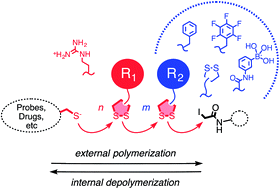- Bang, E.-K.; Ward, S.; Gasparini, G.; Sakai, N.; Matile, S. “Cell-Penetrating Poly(disulfide)s: Focus on Substrate-Initiated Co-Polymerization” Polym. Chem. 2014, 5, 2433-2441

Outperforming cell-penetrating peptides, cell-penetrating poly(disulfide)s are attracting increasing attention. Recently we have shown that cell-penetrating poly(disulfide)s can be grown directly on substrates of free choice before delivery and depolymerized right afterwards. These unique characteristics are compatible with the general, non-toxic, traceless yet covalent delivery of substrates in an unmodified form. The objective of this study was to elaborate on substrate-initiated co-polymerization. The original propagators contain a strained disulfide for ring-opening disulfide-exchange polymerization and a guanidinium cation to assure cell-penetrating activity. Here, we report individually optimized conditions to polymerize these original propagators together with several other propagators. The nature of these new propagators significantly affected polymerization efficiency and conditions as well as size, polydispersity and transport activity of the final co-polymers. According to gel permeation chromatography, the length of co-polymers increases with hydrophobicity, bulk and valency of the co-propagators, whereas ion pairing with boronates gives shorter co-polymers and branching increases polydispersity. The activity of co-polymers increases with length, π-acidity, superhydrophobicity and boronate counterions. Hydrophobicity, π-basicity, bulk and branching appear less important for activity in fluorogenic vesicles. The here reported design, synthesis and evaluation of substrate-initiated co-polymers will be essential to find the best cell-penetrating poly(disulfide)s.
DOI: 10.1039/C3PY01570J
open archive unige:34700 • pdf ![]()
